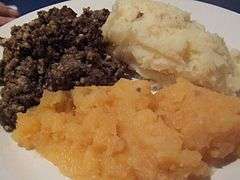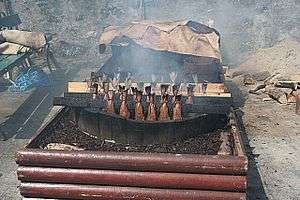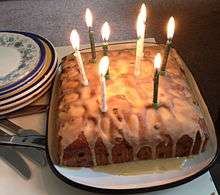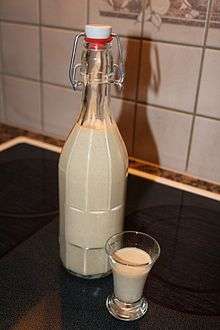Scottish cuisine
| Part of a series on |
| British cuisine |
|---|
| National cuisines |
| Overseas/Fusion cuisine |
|
| Part of a series on the |
| Culture of Scotland |
|---|
 |
| History |
| People |
|
Mythology and folklore
|
| Cuisine |
| Religion |
| Art |
| Literature |
|
Music and performing arts
|
|
Monuments |
|
Scottish cuisine is the specific set of cooking traditions, practices and cuisines associated with Scotland. It has distinctive attributes and recipes of its own, but shares much with wider British and European cuisine as a result of local and foreign influences, both ancient and modern. Traditional Scottish dishes exist alongside international foodstuffs brought about by migration.
Scotland's natural larder of game, dairy products, fish, fruit, and vegetables is the chief factor in traditional Scots cooking, with a high reliance on simplicity and a lack of spices from abroad, as these were historically rare and expensive.
History
Scotland, with its temperate climate and abundance of indigenous game species, has provided a cornucopia of food for its inhabitants for millennia. The wealth of seafood available on and off the coasts provided the earliest settlers with their sustenance. Agriculture was introduced, with primitive oats quickly becoming the staple.[1]
In common with many mediaeval European neighbours, Scotland was a feudal state for a greater part of the second millennium. This put certain restrictions on what one was allowed to hunt, therefore to eat. In the halls of the great men of the realm, one could expect venison, boar, various fowl and songbirds, expensive spices (pepper, cloves, cinnamon, etc.), and the meats of domesticated species. From the journeyman down to the lowest cottar, meat was an expensive commodity, and would be consumed rarely. For the lower echelons of mediaeval Scots, it was the products of their animals rather than the beasts themselves which provided nourishment. This is evident today in traditional Scots fare, with its emphasis on dairy produce. It would appear that the average meal would consist of a pottage of herbs and roots (and when available some meat or stock for flavouring), with bread and cheese when possible.
Before Sir Walter Raleigh's introduction of the potato to the British Isles, the Scots' main source of carbohydrate was bread made from oats or barley. Wheat was generally difficult to grow because of the damp climate. Food thrift was evident from the earliest times, with excavated middens displaying little evidence of anything but the toughest bones. All parts of an animal were used.
The mobile nature of Scots society in the past required food that should not spoil quickly. It was common to carry a small bag of oatmeal that could be transformed into a basic porridge or oatcakes using a girdle (griddle). It is thought that Scotland's national dish, haggis, originated in a similar way: A small amount of offal or low-quality meat, carried in the most inexpensive bag available, a sheep or pig's stomach. It has also been suggested that this dish was introduced by Norse invaders who were attempting to preserve their food during the long journey from Scandinavia.[2]
French influence
During the Late Middle Ages and early modern era, French cuisine played a role in Scottish cookery due to cultural exchanges brought about by the "Auld Alliance",[3] especially during the reign of Mary, Queen of Scots. Mary, on her return to Scotland, brought an entourage of French staff who are considered responsible for revolutionising Scots cooking and for some of Scotland's unique food terminology.
French-derived cooking terms
- "Ashet", from assiette—a large platter.[4]
- "Cannel", from cannelle—cinnamon
- "Collop", from escalope
- "Gigot" /ˈdʒɪɡət/, from gigot—leg of mutton.[4]
- "Howtowdie", from hétoudeau—a boiling fowl (Old French).[4]
- "Syboe", from ciboule—a spring onion[5]
With the growth of sporting estates and the advent of land enclosure in the 18th century, harvesting Scotland's larder became an industry. The railways further expanded the scope of the market, with Scots grouse at a premium (as today) on English menus shortly after the Glorious Twelfth.
20th and 21st centuries
The availability of certain foodstuffs in Scotland, in common with the other parts of the United Kingdom, suffered during the 20th century. Rationing during the two World Wars, as well as large-scale industrial agriculture, limited the diversity of food available to the public. Imports from the British Empire and beyond did, however, introduce new foods to the Scottish public.
During the 19th and 20th centuries there was large-scale immigration to Scotland from Italy, and later from the Middle East, India, and Pakistan. These cultures have influenced Scots cooking dramatically. The Italians reintroduced the standard of fresh produce, and the later comers introduced spice. With the enlargement of the European Union in the early years of the 21st century, there has been an increase in the population of Eastern European descent, from Poland in particular. A number of speciality restaurants and delicatessens catering for the various new immigrants have opened in the larger towns and cities.
Scottish dishes and foods
These dishes and foods are traditional to or originate in Scotland.
CerealsSoups
Fish and seafood
Meat, poultry and game
Vegetables
Fruits |
Cullen skink (right), served with bread 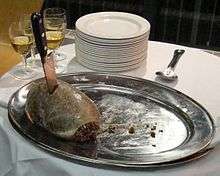 Haggis on a platter at a Burns supper Dairy
Puddings and desserts
Cakes, breads and confectionery
Preserves and spreads |
Drinks
Alcoholic
- 90 shilling ale
- 80 shilling ale
- 70 shilling ale
- India pale ale
- Atholl Brose – prepared using oatmeal brose, honey, whisky, and sometimes cream (particularly on festive occasions)
- Drambuie
- Ginger wine
- Het pint
- Heather ale
- Scotch ale and beer
- Scotch mist – a cocktail containing mainly whisky
- Whisky
Non-alcoholic
Restaurants
In recent years Haggis pakoras have become popular in Indian restaurants.[9]
Fast food
Scotland's reputation for coronary and related diet-based diseases is a result of the wide consumption of fast food since the latter part of the 20th century. Fish and chip shops remain extremely popular, and indeed the battered and fried haggis supper remains a favourite. These have been joined in more recent years by outlets selling pizzas, kebabs, pakoras and other convenience foodstuffs. An extreme example of this style of food is the Munchy box.[10]
In addition to independent fast-food outlets, in the 1960s American-style burger bars and other restaurants such as Wimpy were introduced, and in the 1980s, McDonald's, Burger King, Pizza Hut and Kentucky Fried Chicken appeared in Scotland.
Scottish chefs
See also
Notes and references
- ↑ "Scotland's Traditional Cuisine - a brief overview", Taste of Scotland
- ↑ "Haggis History". MacSweens of Edinburgh. Retrieved 23 October 2006.
- ↑ Gail Kilgore. "The Auld Alliance and its Influence on Scottish Cuisine". Retrieved 29 July 2006.
- 1 2 3 Brown, Catherine (1989). Chapter 9: "Culinary Interchange". In: Scottish Cookery. Glasgow: Richard Drew Publishing. ISBN 0-86267-248-1.
- ↑ "Dictionary of the Scots Language :: SND :: Sybow n.".
- ↑ MacIntosh, John (1894). Ayrshire Nights Entertainments: A Descriptive Guide to the History, Traditions, Antiquities, etc. of the County of Ayr. Pub. Kilmarnock. P. 265.
- ↑ Elizabeth, Hinds. "Classic Scottish Cakes". Cake Baker. Retrieved 19 November 2011.
- ↑ "Dundee Recipe Is Another Standby for the Holidays". The Evening Independent. St. Petersburg, FL. 13 November 1936. p. 13. Retrieved 19 November 2011.
- ↑ Shaheen (2010-01-27). "Mushroom haggis pakoras with curried neep chips". Allotment2Kitchen. Retrieved 2015-08-23.
- ↑ "What is a Munchy Box?". 23x.net. Retrieved 27 October 2009.
Further reading
- Beckwith, Lillian (1976) Lillian Beckwith's Hebridean Cookbook. London: Hutchinson ISBN 978-0-09-127380-4
- Craig, Elizabeth (1956) The Scottish Cookery Book
- --do.-- (1965) What's Cooking in Scotland
- --do.-- (1980) The Scottish Cookery Book
External links
| Wikimedia Commons has media related to Scottish cuisine. |
- Scottish Food — Scottish Food & Drink
